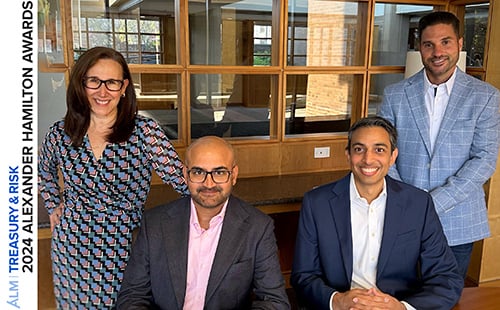
Credit risk management is a big deal for every business—and an even bigger deal for a company as large and complex as Microsoft.
"As Microsoft grew globally, each line of business had a different credit-and-collections team, with each of those teams doing risk assessments in its own way," says Andrey Naumiuk, senior finance manager for the company's Azure Data group. "Credit risk management processes were also fragmented by geography: Many business groups had separate credit teams in the major regions around the world. Their processes were not consistent, so large customers that buy products from multiple Microsoft business groups wouldn't have the same experience across the different product lines."
Recommended For You
One issue was that credit risk managers for high-margin products were typically ready to take more risks than their colleagues in lower-margin lines of business. Another challenge was that groups used their own credit scoring models and based decisions on different data sources. "The data wasn't completely consistent, so the decisions being made based on that information weren't consistent either," Naumiuk says. There were also discrepancies in processes. "For example, in some cases, we took a decision for each additional deal, but in other cases, we established lines of credit that customers could use, pay off, and use again, for years at a time." Comparing results across teams was difficult because they all used different processes.
The situation impacted staff productivity, because some business units' credit processes had a lot of manual touchpoints requiring employee action. And some teams consisted only of credit-and-collections generalists. "The same employee might support the sales team in working with customers, while also doing the credit risk analyses, collections, and reporting."
All told, he says, "we didn't have a consistent, companywide approach to credit risk management. That was not the best way to manage our customer relationships." The inefficiencies impacted working capital and potentially even reduced Microsoft's revenue.
"In the old world, the credit managers had up to five days to take a credit decision," Naumiuk explains. "Five days may not seem like too much time, but Microsoft has revenues of $150 billion a year. If you multiply five days of delay by this huge scale, that's a pretty big impact. And we wouldn't necessarily even get the revenue five days later. We are working in a hypercompetitive world, and there was a risk we might lose a sale if we spent too long thinking."
Microsoft leadership wanted to find a better way for managing customer credit and tasked a five-member project team with discovering and implementing it. In addition to Naumiuk, whose background was in credit risk and machine learning, the team included individuals with vast experience in process excellence, technology, and risk management. Still, the project's goals initially seemed impossible.
"Our leader asked us to simultaneously lower risk, decrease operating costs, and—even more important—improve revenue by taking decisions faster," Naumiuk says. "But if you want to increase sales, that inevitably means you need to ease your credit rules and take more risks. By contrast, if you reduce risk and tighten credit, that will negatively impact sales. And either change is likely to increase operating costs. Having these seemingly contradictory goals inspired us to think outside the box. Originally, we had no idea how we could accomplish all three at the same time."
 Naumiuk, who is a history buff, was inspired by a previous era. "Textile manufacturers in the late 18th century faced a similar challenge," he says. "They wanted to both increase production and decrease their costs. To do both, they harnessed the power of steam energy. This led to the first Industrial Revolution, which started in England, then spread around the world.
Naumiuk, who is a history buff, was inspired by a previous era. "Textile manufacturers in the late 18th century faced a similar challenge," he says. "They wanted to both increase production and decrease their costs. To do both, they harnessed the power of steam energy. This led to the first Industrial Revolution, which started in England, then spread around the world.
"Luckily, we live in the fourth Industrial Revolution," he adds. "Today, paradigm shifts are all about bringing machine learning, artificial intelligence, and cloud computing to bear on crucial business processes. When we looked at our challenge, it was clear that the only way to achieve all the project's goals would be to introduce artificial intelligence into our credit risk decision-making."
The project team first undertook a consolidation of credit management companywide and a standardization of processes. Although some credit risk managers continue to work in locations around the world, the team is now structured around capabilities rather than lines of business. It consists of a collections team, a risk analysis team, and a field support and reporting group.
"Credit risk managers today are thinking only about credit decisions," Naumiuk says. "They don't spend a lot of time on reporting or collections. This increased specialization has improved efficiency throughout Microsoft's credit management organization. Staff have more expertise and experience within their area, so they can accomplish more within the same time frame."
The project team also greatly simplified credit decision-making. "In the old world, many of our teams had a huge number of metrics," Naumiuk says. "About 50 different elements were underlying Microsoft credit decisions. There are still differences in credit management between lines of business, but all decisions are now based on about 10 elements, with data coming from just two data providers." Having everyone work off of the same information has increased consistency in corporate credit decisions.
Next, the project team developed a machine learning (ML) tool that they trained to handle all but the most complex credit decisions. They allowed for differences between products and geographic regions, yet they aimed to have the system make the vast majority of credit decisions.
One key realization, Naumiuk says, was that "for smaller deals, we didn't need to rely much on external data providers. Over Microsoft's four decades of being in business, we have developed a wealth of experience and data about different customers and different countries. We have a presence in every industry in every country around the world. So, even if we don't have experience with a particular prospect, we might have a similar customer in the same part of the world. We figured we could make assumptions about the prospect's risk and take a decision based on our historical data on similar organizations."
To evaluate the quality of ML-driven credit decisions, the project team tested its newly developed algorithms using historical data on customer defaults and adjusted as needed to improve the decisions. That process was key to the project's success, but it was challenging.
"It's difficult to completely standardize the data inputs for credit decisions," Naumiuk says. "A human credit risk manager thinks about many aspects of the economy, about the country's political situation, how the industry behaves, and how similar companies are performing. But when you work with machine learning, you have to standardize the input of data and make sure that you have comparable data around the world, across different industries, different types of products, different types of companies."
After a period of tweaking, Naumiuk says, the algorithm delivered promising results. "The quality of decisions was very comparable to decisions taken by humans, and the ML system displayed more consistency than human decision-makers. Best of all, the ML tool takes decisions instantly."
Today, Microsoft credit processes route large and complex deals for human consideration, as well as some decisions in which there isn't enough information available on the customer. However, the vast majority of all Microsoft sales transactions now involve automated credit decisions. Not only that, but the new ML system provides a credit rating to support more than 99 percent of transactions.
"Almost all the decisions we take today are based on an ML estimate of the probability of default," Naumiuk says. "This has led to a big improvement in the quality of decisions. We have seen a significant improvement in collections performance. At the same time, the automation means that about 95 percent of our credit decisions are instantaneous. So, we've gone from five days to no time at all. If you divide those five days saved by 365 days in a year, times $150 billion in annual sales volume, you can see the vast impact this project has had on Microsoft's cash flows."
In addition, he adds, the project has improved customers' experience working with Microsoft: "It's difficult to quantify, but this project is not only improving working capital and decreasing risk—it's also driving revenue."
Ultimately, the project achieved all three of the goals the leadership team set out up front. "I think the main learning from my experience with this project is that there is no unsolvable issue," Naumiuk concludes. "To achieve a highly ambitious goal, you might need to bring drastic changes. But technologies available today can solve all kinds of problems that treasury professionals face in our daily work. Artificial intelligence, machine learning, and cloud computing have the potential to significantly increase the productivity of treasury teams—across different companies, across different countries—and bring value to those companies' customers."
© Touchpoint Markets, All Rights Reserved. Request academic re-use from www.copyright.com. All other uses, submit a request to [email protected]. For more inforrmation visit Asset & Logo Licensing.



